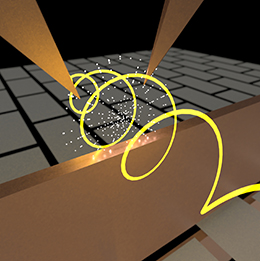Jan 13 2020
An innovative type of detector that allows accurate determination of the oscillation profile of light waves has been developed by physicists in the Laboratory for Attosecond Physics at LMU Munich and the Max Planck Institute for Quantum Optics (MPQ).
 How a novel type of detector enables the oscillation profile of light waves to be precisely determined. Image Credit: Philipp Rosenberger.
How a novel type of detector enables the oscillation profile of light waves to be precisely determined. Image Credit: Philipp Rosenberger.
Light waves travel with a speed of nearly 300,000 km per second, and in the same interval, the wavefront oscillates several hundred trillion times.
For visible light, the physical distance between subsequent light wave peaks is less than 1 μm, and peaks are separated in time by less than three-millionths of a billionth of a second or less than 3 fs. Light must be controlled in order to work with it. This necessitates accurate knowledge of its behavior.
Also, it may be essential to gain insights into the precise position of the valleys or crests of the light wave at a specified instant. At present, scientists based at the Laboratory for Attosecond Physics (LAP) (at the LMU Munich and the Max Planck Institute for Quantum Optics) have been able to measure the precise location of such peaks inside single ultrashort pulses of infrared light, using a newly designed detector.
Pulses such as these encompass just a few oscillations of the wave, and can be employed to analyze the behavior of molecules and the atoms that constitute the molecules. In this regard, the new detector is a very useful tool. Ultrashort laser pulses enable researchers to analyze dynamic processes at molecular or even subatomic levels.
Trains of these pulses can be used to first excite the target particles and subsequently film their reactions in real-time. However, in intense light fields, it is vital to learn the exact waveform of the pulses. As the oscillating (carrier) light field’s peak and the peak of the pulse envelope can shift relative to each other between distinct laser pulses, it is crucial to identify the exact waveform of each pulse.
Currently, the team from LAP, headed by Dr Boris Bergues and Professor Matthias Kling, head of the Ultrafast Imaging and Nanophotonics Group, has achieved a crucial progress in light waves characterization. The new detector designed by them enables determination of the “phase,” that is, the exact positions of the peaks of the few oscillation cycles within each pulse, at repetition rates of 10,000 pulses per second.
The researchers performed this by synthesizing circularly polarized laser pulses where the propagating optical field’s orientation rotates similar to a clock hand. The rotating pulse was then focused into ambient air. The interaction between the molecules and the pulse in the air leads to a short burst of electric current, the direction of which is dependent on the light wave peak’s position.
The team studied the precise direction of the current pulse, thereby retrieving the phase of the “carrier-envelope offset.” This enabled them to reconstruct the light wave’s form.
In contrast to the technique traditionally used for determining the phase, which necessitates a complex vacuum apparatus to be used, the new method works in ambient air and the measurements need very few additional components.
The simplicity of the setup is likely to ensure that it will become a standard tool in laser technology.
Matthias Kling, Professor and Head of the Ultrafast Imaging and Nanophotonics Group, Laboratory for Attosecond Physics, LMU Munich
“We believe that this technique can also be applied to lasers with much higher repetition rates and in different spectral regions,” stated Boris Bergues.
Our methodology is of particular interest in the context of the characterization of extremely short laser pulses with high repetition rates, such as those generated at Europe’s Extreme Light Infrastructure (ELI).
Matthias Kling, Professor and Head of the Ultrafast Imaging and Nanophotonics Group, Laboratory for Attosecond Physics, LMU Munich
Upon being applied to the most recent ultrashort laser pulse sources, this new waveform analysis technique could open the door to technological advancements, and also offer a new understanding about the behavior of elementary particles “in the fast lane.”